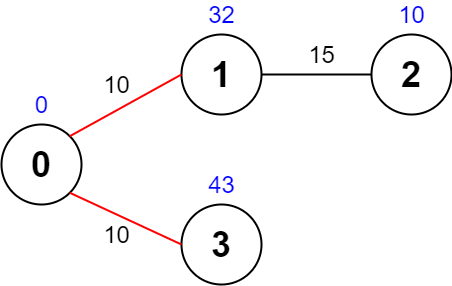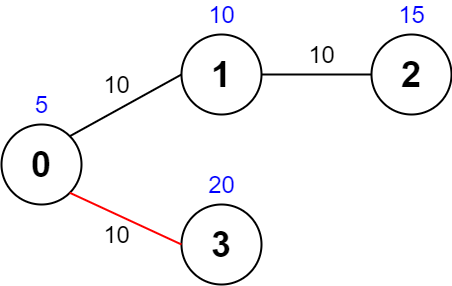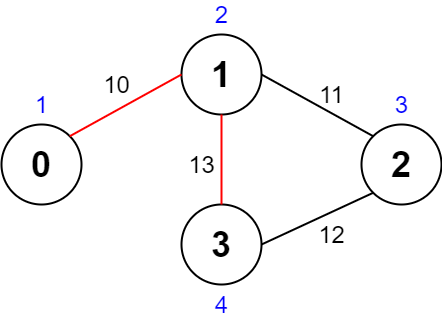- {x}
- Smallest Index With Equal Value
- Find the Minimum and Maximum Number of Nodes Between Critical Points
- Minimum Operations to Convert Number
- Check if an Original String Exists Given Two Encoded Strings
- Number of Spaces Cleaning Robot Cleaned
- Count Vowel Substrings of a String
- Vowels of All Substrings
- Minimized Maximum of Products Distributed to Any Store
- Maximum Path Quality of a Graph
- Account Balance
- Number of Equal Count Substrings
- Check Whether Two Strings are Almost Equivalent
- Walking Robot Simulation II
- Most Beautiful Item for Each Query
- Maximum Number of Tasks You Can Assign
- The Winner University
- Time Needed to Buy Tickets
- Read More...

Maximum Path Quality of a Graph
There is an undirected graph with n nodes numbered from 0 to n - 1 (inclusive). You are given a 0-indexed integer array values where values[i] is the value of the ith node. You are also given a 0-indexed 2D integer array edges, where each edges[j] = [uj, vj, timej] indicates that there is an undirected edge between the nodes uj and vj, and it takes timej seconds to travel between the two nodes. Finally, you are given an integer maxTime.
A valid path in the graph is any path that starts at node 0, ends at node 0, and takes at most maxTime seconds to complete. You may visit the same node multiple times. The quality of a valid path is the sum of the values of the unique nodes visited in the path (each node's value is added at most once to the sum).
Return the maximum quality of a valid path.
Note: There are at most four edges connected to each node.
Example 1:

Input: values = [0,32,10,43], edges = [[0,1,10],[1,2,15],[0,3,10]], maxTime = 49 Output: 75 Explanation: One possible path is 0 -> 1 -> 0 -> 3 -> 0. The total time taken is 10 + 10 + 10 + 10 = 40 <= 49. The nodes visited are 0, 1, and 3, giving a maximal path quality of 0 + 32 + 43 = 75.
Example 2:

Input: values = [5,10,15,20], edges = [[0,1,10],[1,2,10],[0,3,10]], maxTime = 30 Output: 25 Explanation: One possible path is 0 -> 3 -> 0. The total time taken is 10 + 10 = 20 <= 30. The nodes visited are 0 and 3, giving a maximal path quality of 5 + 20 = 25.
Example 3:

Input: values = [1,2,3,4], edges = [[0,1,10],[1,2,11],[2,3,12],[1,3,13]], maxTime = 50 Output: 7 Explanation: One possible path is 0 -> 1 -> 3 -> 1 -> 0. The total time taken is 10 + 13 + 13 + 10 = 46 <= 50. The nodes visited are 0, 1, and 3, giving a maximal path quality of 1 + 2 + 4 = 7.
Constraints:
n == values.length1 <= n <= 10000 <= values[i] <= 1080 <= edges.length <= 2000edges[j].length == 30 <= uj < vj <= n - 110 <= timej, maxTime <= 100- All the pairs
[uj, vj]are unique. - There are at most four edges connected to each node.
- The graph may not be connected.
Solution Explanation: Maximum Path Quality of a Graph
This problem asks to find the maximum quality of a path in a graph, starting and ending at node 0, with a maximum allowed time. The quality is the sum of unique node values visited.
Approach: Depth-First Search (DFS)
The most efficient approach is to use Depth-First Search (DFS) to explore all possible paths within the time constraint. Since the maximum time is relatively small and each node has at most four edges, a brute-force DFS is feasible.
Algorithm:
-
Graph Representation: Represent the graph using an adjacency list. Each node stores a list of its neighbors and the corresponding edge weights (times).
-
DFS Function: The core of the solution is a recursive DFS function:
dfs(u, cost, value, visited):u: The current node.cost: The accumulated time cost of the path so far.value: The accumulated quality (sum of unique node values) of the path so far.visited: A set to track visited nodes (to ensure unique node value summation).
-
Base Case: If the current node
uis 0 (the starting node) and we've returned, update the maximum quality (ans) if the current path's quality is higher. -
Recursive Step: For each neighbor
vof the current nodeu, check if adding the edge time to the current cost exceedsmaxTime. If not:- If
vis already visited, recursively calldfs(v, cost + time, value, visited). - If
vis not visited, add it tovisited, updatevaluewithvalues[v], recursively calldfs(v, cost + time, value, visited), and then removevfromvisited(backtracking).
- If
-
Initialization: Start the DFS from node 0 with initial cost 0, value
values[0], and an empty visited set.
Time and Space Complexity:
- Time Complexity: O(N * 4T/min_time), where N is the number of nodes and T is
maxTime. The exponential factor comes from the branching in the DFS; in the worst case, we explore all possible paths, which can grow exponentially with the maximum allowed time. Themin_timeis the shortest edge weight which limits the maximum depth of the DFS tree. - Space Complexity: O(N + E + T/min_time), where E is the number of edges. The space is dominated by the recursion stack (depth proportional to
T/min_time) and the adjacency list.
Code (Python):
def maximalPathQuality(values, edges, maxTime):
n = len(values)
graph = [[] for _ in range(n)]
for u, v, t in edges:
graph[u].append((v, t))
graph[v].append((u, t))
ans = 0
def dfs(u, cost, value, visited):
nonlocal ans
if u == 0:
ans = max(ans, value)
return
for v, t in graph[u]:
if cost + t <= maxTime:
new_visited = set(visited)
if v not in new_visited:
new_visited.add(v)
dfs(v, cost + t, value + values[v], new_visited)
else:
dfs(v, cost + t, value, new_visited)
visited = {0}
dfs(0, 0, values[0], visited)
return ansThe code in other languages (Java, C++, Go, TypeScript) follows a very similar structure, using their respective data structures and syntax. The key algorithmic idea remains the same – a depth-first search that explores paths within the time constraint and tracks visited nodes for quality calculation.